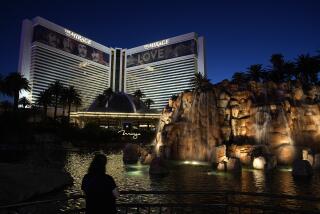A High-Stakes Gamble
Las Vegas — Can Steve Wynn hit the jackpot again?
Five years after he sold his Las Vegas holdings, Wynn is returning to the Strip with the most expensive project ever seen in a city famous for its extravagant hotels.
When the $2.7-billion Wynn Las Vegas opens April 28, it will compete against his former properties, including the Mirage and the Bellagio, for the high-end vacationers and gamblers that keep Vegas rolling. His company, Wynn Resorts Ltd., will face deep-pocketed corporate rivals, including two behemoths that soon may control about two-thirds of the hotel rooms on the Strip.
Chief Executive Wynn, who turned 63 last week, clearly relishes the thought of going up against the other big casinos.
“This is a business that thrives on competition,” he said in a recent interview. “For 24 hours a day, seven days a week, the Strip hosts the most violent competition in business in America.”
The competition isn’t only for customers: To fill 8,000 jobs, Wynn has been raiding adversaries’ payrolls. Caesars Palace has lost several executives, including its chief financial officer, and MGM Mirage expects about 2,000 employees, or more than 5% of its workforce, to defect to Wynn.
“He’s going to take a whole lot of people out of here,” said Floyd Cross, the shoeshine man at the Bellagio. “He is a good boss who doesn’t mind spending money on employees.”
Wynn, the son of a bingo parlor operator, moved here in 1967 and is credited with igniting a new golden era for Vegas. In the late 1980s, the company he then owned, Mirage Resorts, launched a massive and decade-long building program on the Strip, completing richly detailed hotels appointed with fine restaurants, swank shopping areas, classy art and venues for entertainment acts such as Cirque du Soleil and Siegfried & Roy.
Rivals spent billions of dollars to keep pace. In the process they transformed Las Vegas from a town of cheap buffets and smoky casinos into a diversified tourism powerhouse.
Wynn walked away, with some $400 million in his pocket, after selling Mirage Resorts to Kirk Kerkorian’s MGM Grand for $6.4 billion in June 2000.
Today, MGM Grand is part of MGM Mirage. In June, it made a deal to acquire Mandalay Resort Group for $7.9 billion. If the purchase clears antitrust hurdles, MGM-Mandalay would own 36,500 rooms, 22,000 slot machines and 1,050 table games at the Bellagio, MGM Grand, Mandalay Bay Resort and eight other hotels along the Strip.
In July, Harrah’s Entertainment Inc. agreed to purchase Caesars Entertainment Inc. for $9.5 billion. If antitrust regulators OK that deal, Harrah’s-Caesars would have six major Strip-area properties -- Caesars Palace, Paris Las Vegas, the Flamingo, Bally’s, Harrah’s and the nearby Rio -- with nearly 17,000 rooms, 9,200 slot machines and more than 500 gambling tables.
Considering all that, Wynn Resorts isn’t big, with only the one hotel -- albeit a big one with about 2,700 rooms and suites.
Wynn believes that his single property would be large enough to go toe-to-toe with MGM-Mandalay and Harrah’s-Caesars.
“Once you have a hotel with 3,000 rooms, you can buy vodka as cheap as anyone in the world,” he said.
What’s more, Wynn Las Vegas sits on just one bit of the former home of the Desert Inn, 217 acres Wynn bought for $270 million after selling the Mirage to Kerkorian. (Wynn said he donned a cowboy hat and fake beard on one scouting trip to the Desert Inn site, not wanting to stir up rumors of his interest and drive up the price.)
Wynn reckons there is enough space at the site for as many as 12,000 rooms, and he already has started sketching out plans for Encore at Wynn Las Vegas, an all-suite hotel tower with 1,500 rooms that would cost about $900 million to complete and could open in 2007.
With the Desert Inn property, he said, “I have all the land I need for the rest of my career.”
At Wynn Las Vegas, most of the rooms come with floor-to-ceiling views of the property’s 18-hole golf course, an artificial mountain that fronts the Strip and a small lake. The nightly rate for a basic room will range from the mid-$200s to the mid-$300s.
The hotel is the new home for Wynn’s personal collection of art by Gauguin, Matisse, Cezanne, Van Gogh, Rembrandt and Picasso. Beyond that, the site boasts an 111,000-square-foot casino, a spa, multiple swimming pools, sculptured gardens, an auditorium for a show designed by former Cirque du Soleil impresario Franco Dragone and a collection of designer shops, including Chanel, Louis Vuitton, Cartier and Oscar de la Renta.
Once Wynn Las Vegas is open for business in April, analysts and Vegas observers said, the new battleground on the Strip will be for high rollers. This group includes the well-heeled vacationer who unblinkingly pays $400 a night for a hotel room and $150 for a show ticket, as well as the few hundred gamblers in the world who are willing to risk $1 million at the tables in a single visit -- the highest of the high rollers known as “whales.”
Right now, for instance, MGM Mirage has about 50% of the high-end baccarat revenue in town, which averages more than $430 million a year, said analyst David R. Hargreaves of KBC Financial Products in New York. But how long MGM Mirage will hold on to that is anyone’s guess.
“We suspect Steve kept his Rolodex” of high rollers, Hargreaves said.
Indeed, one of Wynn Las Vegas’ first hires was Larry Antschul, the former senior vice president of casino marketing at Caesars Palace, where his job was to recruit whales.
Competitors face the prospect “of losing a significant portion of high-end play to Wynn, and they will have to spend more to keep what they retain,” said Patricia Wright, an industry analyst with Fitch Ratings in New York.
Some in the business are worried about a return to the so-called discount war of four years ago, when top resorts often forgave portions of the losses incurred by high-stakes gamblers. In some instances the discounts amounted to hundreds of thousands of dollars, one casino executive said. In one case, a casino gave a client a red Ferrari to soften the blow of several million dollars in losses over a multi-week period.
But MGM Mirage Chief Executive Terri Lanni, for one, isn’t anxious. He figures there are more than enough whales to go around.
The number of high rollers “grows every day” with the creation of millionaires in China and other parts of the world, he said. In any event, “Wynn builds very desirable, exciting properties that bring lots of new people to town. That is going to be good for everybody.”
Many expect that Wynn’s new property will be the most posh in town. But analyst Hargreave doesn’t expect Wynn Las Vegas to revolutionize the Strip. He said he doubted that “this property will debut any groundbreaking design concepts that will reset the bar for luxury resorts -- there aren’t that many original ideas out there.”
Indeed, Wynn’s latest venture looks very much like a replay of his Bellagio project, which started in 1993 when he bought the 166-acre Dunes property for $70 million.
In both the Dunes and the Desert Inn transactions, Wynn took advantage of a quirk in the way casino properties are valued. Until the large increases in Las Vegas land values in recent years, especially along the Strip, gambling enterprises were valued by their cash flow. Both properties were struggling against newer, brighter competition -- much of it built by Wynn -- and had distress sale prices.
Wynn didn’t care about the casinos. He was going to level them. What was important, he said, was the land value and what could be done with it.
For its part, Wall Street has given Wynn a vote of confidence. Wynn Resorts went public three years ago at $13 a share, and its stock closed Friday at $62.87 on Nasdaq -- almost a 400% gain.
Wynn Resorts also holds a license to operate a casino in Macao, a special administrative region of China, where the company plans to open a 600-room, $700-million resort in late 2006.
“I have developer’s disease,” Wynn said in the interview. “I love to sit at a drafting table and draw plans for hotels, wrestling with problems of traffic and the flow of people. That’s what turns me on.”
Wynn said it wasn’t possible these days to build a casino, switch on a big neon sign and expect anyone to walk in off the street.
“People want a unique experience: good restaurants, great entertainment, fanciful environments, beautiful architecture. That is what people will get on an airplane for,” he said. “If your business is just about slot machines, you are very vulnerable.”
The sign atop the curved bronze tower of the 50-story Wynn Las Vegas is a script “Wynn,” with a period.
The name still means something. Wynn represents “money, big money,” said Steve Schmillen of Ottawa, Ill., as he played nickel video poker at the Bellagio. “After all, he built all this.”
More to Read
Inside the business of entertainment
The Wide Shot brings you news, analysis and insights on everything from streaming wars to production — and what it all means for the future.
You may occasionally receive promotional content from the Los Angeles Times.











